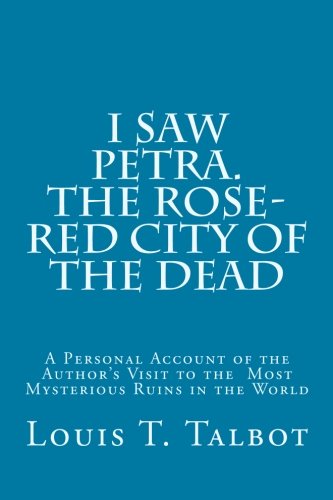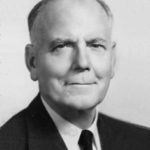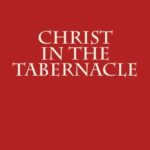Description
I SAW PETRA
The Rose-Red City of the Dead
A Personal Account of the
Author’s Visit to the
Most Mysterious Ruins in the World
by
Louis T. Talbot
2014
To visit Petra, that incredible rose-colored ruin of antiquity, mysteriously concealed from this modern world in a remote rocky basin of Trans-Jordania, between the Dead Sea and the Gulf of Aqaba, had been my ambition for years. This desire was deepened by travel reports I had heard and read and by pictures I had seen, but, most of all, by an intensive study of the Word of God in which it seemed to me that Petra held a strategic spot both in fulfilled and unfulfilled prophecy.
So when on a recent missionary survey for the Bible Institute of Los Angeles, my travels took me in that direction, and I was permitted not only to behold with my own eyes that astonishing site, but also to photograph it for missionary purposes, my delight and gratitude knew no bounds. It was the fulfillment of a cherished dream.
The Amazing Siq
Indeed I felt as if actually I were in a dream when on that bright December day, mounted on a small Arabian horse, I seemed to be riding straight into the face of a massive pink mountain. It was like another world to enter that extraordinary canyon so appropriately named Es Siq (a cleft”) by the Arabs. For it certainly looked as if God Himself by His own hand had split in two the sandstone mountains of Petra to make a way into the rock city of the dead. It did not seem real at all, but was of the essence of dreams.
In fact, I had not fully recovered from the tremendous emotional experiences of the previous weeks when I had visited the sacred sites of the Holy Land, traversing the village streets where my Lord had walked in the days of His flesh; preaching on Christmas Day in the shepherds’ fields; standing with bowed head at the place of a skull, and entering with awe the garden tomb. Damascus, Tyre, Sidon, Amman had followed, each with its own unmistakable evidences of Biblical prophecies fulfilled to the letter making an indelible impression upon my heart.
Then finally there was a night at an Arab fortress in the barren land of Edom with the prospect of a visit to mysterious Petra on the morrow! No wonder sleep fled from me and that at dawn I was ready for my Arabian guide. For seven hours we proceeded at a snail’s pace over barren desert rimmed by the Idumean hills. The only signs of life were a few wretched Bedouins with their even more wretched half-starved sheep for which not a blade of grass was visible. In the distance rose massive Mount Hor, on which Aaron is buried; at the rear lay the Wilderness of Sin. As I gazed at the great stretches of that waste No Man’s Land which intervened, I said to myself: “So this is what happens to a land which falls under the judgment of God.”
At last we dropped several thousand feet into the stony, almost circular, valley, which continues the great divide of the Jordan. This was the Wadi Musa (“Valley of Moses”) which is what the Arabs call Petra, scorning the Greek word Petra, the Aramaic, Rekem, and the Hebrew, Sela, all of which mean “rock”. We passed the suburbs of what was once Petra city proper containing tombs of the pylon type cut from rock and numerous white sandstone domes. The vale grew narrower and deeper until we reached what appeared to be a dead-end, but which was in reality this amazing Siq, the only means of entering the rose-red city. It is a river-bed which is flooded in winter by a stream the Arabs claim originated from the water Moses produced by striking the rock in the wilderness.
There appeared to be no exit from that dim, dark corridor. I did not wonder that the Bedouins refused to travel there alone at night, but always made their way in companies, shouting and singing to drive off the evil spirits.
Hemmed in on either side by towering perpendicular peaks rising hundreds of feet, we followed the tortuous trail over broken antique paving stones and sharp pebbles, as it turned and twisted in quick bends and sharp curves, past great pink oleander bushes, shrines to forgotten gods and statues of dead heroes carved into the walls, and protruding clay pipes of ancient water mains. I gazed upward in wonder. The craggy pinnacles seemed to touch, now shutting out the light, now revealing a flash of blazing blue sky. Over the whole scene there fell such an eerie glow as the sunlight and shadow played upon the sandstone cliffs, changing them by turns to pastel pink, blush rose, deep purple or ruby-red, that I had the impression of being in a roseate Dreamland, filled with strange shadows of by-gone generations.
No sound but that of horses’ hoofs broke the silence; the atmosphere was heavy, but at the same time there was a strange air of anticipation, as if something significant was about to happen. The Siq describes a sort of semi-circle, varying in width from twelve to forty feet, and extends nearly two miles in length. As I rode along, I thought of the mighty caravans that once, laden with treasures, had made their way in single file along this trail. I wondered if perchance any messenger of God had ever brought the good news of salvation to the civilizations that had risen and fallen in the rose-red city. Surely God had planned and preserved this narrow defile and what lay beyond it throughout the ages for some glorious design of His own, not as yet revealed to mankind.





Reviews
There are no reviews yet.